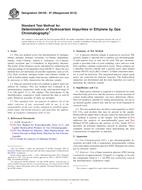Potrebujeme váš súhlas na využitie jednotlivých dát, aby sa vám okrem iného mohli ukazovať informácie týkajúce sa vašich záujmov. Súhlas udelíte kliknutím na tlačidlo „OK“.
ASTM B890-07(2012)
Standard Test Method for Determination of Metallic Constituents of Tungsten Alloys and Tungsten Hardmetals by X-Ray Fluorescence Spectrometry
Automaticky preložený názov:
Štandardná skúšobná metóda pre stanovenie kovových zložiek zliatiny volfrámu a volfrám tvrdokovov X-Ray fluorescenčnej spektrometrie
NORMA vydaná dňa 1.10.2012
Informácie o norme:
Označenie normy: ASTM B890-07(2012)
Poznámka: NEPLATNÁ
Dátum vydania normy: 1.10.2012
Kód tovaru: NS-8642
Počet strán: 5
Približná hmotnosť: 15 g (0.03 libier)
Krajina: Americká technická norma
Kategória: Technické normy ASTM
Kategórie - podobné normy:
Anotácia textu normy ASTM B890-07(2012) :
Keywords:
absorption and enhancement effects, fusion, interelement effects, tungsten alloys, tungsten carbides, tungsten hardmetals, X-ray fluorescence spectrometry, ICS Number Code 71.040.50 (Physicochemical methods of analysis), 77.040.30 (Chemical analysis of metals)
Doplňujúce informácie
| Significance and Use | |
|
5.1 This test method allows the determination of the chemical composition of powdered and sintered tungsten-based hardmetals. This test method is not applicable to material which will not oxidize readily at high temperatures in air, such as tungsten/copper or tungsten/silver alloys. 5.2 This test method specified lithium-borate compounds for the glass fusion material. However, numerous other choices are available. These include other lithium-borate compounds, sodium carbonate and borate mixtures, and others. The methodology specified here is still applicable as long as the same fusion mixture is used for both standards and specimens. |
|
| 1. Scope | |
|
1.1 This test method describes a procedure for the determination of the concentration, generally reported as mass percent, of the metallic constituents of tungsten-based alloys and hardmetals utilizing wavelength dispersive X-ray fluorescence spectrometry (XRF). This test method incorporates the preparation of standards using reagent grade metallic oxides, lithium-borate compounds, and fusion techniques. This test method details techniques for preparing representative specimens of both powder and sintered tungsten-based material. This test method is accurate for a wide range of compositions, and can be used for acceptance of material to grade specifications. 1.2 This test method is applicable to mixtures of tungsten or tungsten carbide with additions of refractory metal carbides and binder metals. Table 1 lists the most common elemental constituents and their concentration range. Note that many of these occur as metallic carbides. Element |
Concentration, Mass % |
|
Chromium (Cr) |
0.05 - 5.0 |
|
Cobalt (Co) |
0.05 - 40 |
|
Hafnium (Hf) |
0.05 - 2.0 |
|
Iron (Fe) |
0.05 - 2.0 |
|
Molybdenum (Mo) |
0.05 - 5.0 |
|
Nickel (Ni) |
0.05 - 30 |
|
Niobium (Nb) |
0.05 - 15 |
|
Tantalum (Ta) |
0.05 - 30 |
|
Titanium (Ti) |
0.05 - 30 |
|
Vanadium (V) |
0.05 - 2.0 |
1.3 This standard does not purport to address all of the safety concerns, if any, associated with its use. It is the responsibility of the user of this standard to establish appropriate safety and health practices and determine the applicability of regulatory limitations prior to use.
|
Standard Terminology Relating to Analytical Chemistry for Metals, Ores, and Related Materials (Includes all amendments and changes 7/17/2023). |
|
|
Standard Guide for Correction of Interelement Effects in X-Ray Spectrometric Analysis |



 ASTM D6071-14
ASTM D6071-14 ASTM D6132-13
ASTM D6132-13 ASTM D6142-12
ASTM D6142-12 ASTM D6144-13
ASTM D6144-13 ASTM D6159-97(2012)..
ASTM D6159-97(2012).. ASTM D6229-06(2010)..
ASTM D6229-06(2010)..
 Cookies
Cookies
